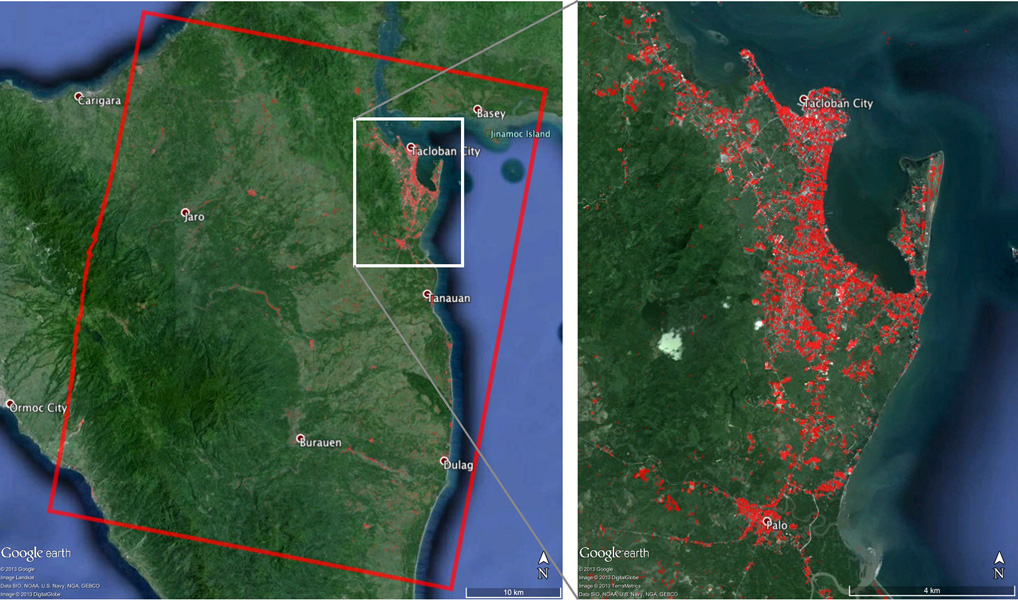Typhoon Haiyan
Status: Closed
| Type of posting | Posting date(EST): | Summary | Downloads |
|---|---|---|---|
| Post Landfall 2 | 11/15/2013 12:00:00 PM |
|
|
| Post Landfall 1 | 11/11/2013 5:00:00 AM |
|
|
| Landfall | 11/8/2013 11:45:00 AM |
|
|
| Pre-Landfall 1 | 11/7/2013 12:45:00 PM |
|
Post Landfall 2 | Summary
Posting Date: November 15, 2013, 12:00:00 PM
AIR Worldwide estimates that insured losses from Super Typhoon Haiyan will range between USD 300 million and USD 700 million, and total ground-up losses will range between USD 6.5 billion and USD 14.5 billion.
ALERT subscribers will receive further information in a separate email.
AIR’s industry insured loss estimates reflect:
- Insured physical damage to property (residential, commercial, and agricultural), for both structures and their contents, due to wind and precipitation-induced flooding in the Philippines
- AIR’s assumed take-up rates—that is, the percentage of properties in the Philippines that are actually covered against wind and flood damage
AIR’s industry insured loss estimates do not include:
- Losses to uninsured properties
- Losses to infrastructure
- Losses from storm surge
- Losses to crops
- Losses to auto
- Losses resulting from physical failure of flood defenses
- Losses from hazardous waste cleanup, vandalism or civil commotion whether directly or indirectly caused by the event
- Demand surge
- Business interruption
- Other nonmodeled losses
Super Typhoon Haiyan made landfall on the southern tip of Samar Island early morning local time on November 8 as one of the most powerful tropical cyclones in modern record-keeping. The storm maintained impressive wind speeds as it traversed the Philippines before exiting over the cooler waters of the South China Sea, where it weakened as it headed northwest.
The storm created a humanitarian disaster in the Philippines as it swept away small villages in its path, left over 2,000 people dead, and displaced more than 650,000 people. Currently, organizations and nations from around the world are rushing to deliver aid, but their efforts have been complicated by power outages, blocked roads, and rain from a tropical depression on November 12. The perceived slow arrival of food, water, and medical supplies—particularly to those in remote areas—has frustrated many survivors and led to rising tensions. However, a presidential spokesman stated on November 12 that supplies should increase in coming days now that the airport and a bridge to the island of Leyte are open.
Observed Damage
The islands of Leyte, Samar, and northern Cebu are among the worst affected areas. Tacloban City, the capital and biggest city (population of 220,000) of Leyte province was particularly hard hit as storm surges as high as 4 meters destroyed every coastal home and left many inland neighborhoods inundated with floodwaters. Many inland residential and commercial buildings were also destroyed, and the tiny peninsula where the Tacloban airport was once located was leveled, leaving only the runway. Nearly every tree in the city was either flattened or snapped in half. These fallen trees and other debris have blocked roads both in and around the city.
Guiuan, a municipality located very close to where the typhoon made landfall, was also left in ruins. Aerial photos from the region show destroyed neighborhoods, flattened trees, and blocked roads. Photos also showed rice fields in Lloilo province filled with water and damaged houses in Capiz province.
In this map of Leyte Province, the areas that experienced the most damage are shown in red. The estimated intensity of the damage is proportional to the opacity of the red. (Source: NASA)
Modeled Losses
A crucial component of providing an accurate insured loss estimate is ascertaining the storm’s exact strength at landfall. However, this is a challenging task, particularly for Haiyan, given that no known anemometers in the vicinity of landfall survived the storm. Also, as is typical, there are discrepancies in the storm’s reported intensity from various agencies. For example, the Joint Typhoon Warning Center (JTWC) identifies Super Typhoon Haiyan as the most intense landfalling typhoon ever recorded with 195 mph winds (satellite-derived estimate). The Japan Meteorological Agency (JMA) describes the storm as the most intense landfalling storm for the Western Pacific Basin—but at a lower intensity with 165 mph winds (also a satellite-derived estimate).
To produce loss estimates for Haiyan, AIR chose the track information from the JMA, which has Haiyan making landfall on Samar Island with a central pressure of 895 mb, for several reasons. First, in the AIR Typhoon Model for Southeast Asia, storm intensity is calculated using a basin-specific formula derived from historical data from 1971–2008 that relates central pressure to maximum wind speed for typhoons in the Northwest Pacific basin. Note that central pressure is a more reliable metric of intensity as barometers are much more durable than anemometers. Importantly, this formula is based on information from the JMA and has been validated using data from previous storms in which anemometers have remained intact.
Second, the JMA’s estimate of lower wind speeds is consistent with the fact that Haiyan underwent an eyewall-replacement cycle the day before the storm made landfall, which resulted in a larger radius of maximum winds. It is unlikely that the operational satellite-derived intensity estimate from JTWC would have fully incorporated this feature.
AIR used the JMA track information to consider several different scenarios that reflect a range of radius of maximum wind values. Based on running these scenarios using the AIR Typhoon Model for Southeast Asia, AIR estimates industry-wide insured losses of between USD 300 million and USD 700 million, and ground-up losses between USD 6.5 billion and USD 14.5 billion.Note that these losses have been trended to reflect current exposures and exchange rates.
The wide range in the modeled ground-up and insured losses reflects uncertainty in the meteorological parameters associated with this event. For the insured loss estimation, there is additional uncertainty in the take-up rates (insurance penetration) for the Philippines.
ALERT subscribers will receive further information in a separate email.